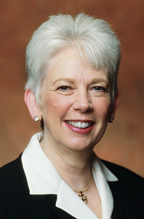
Presidential Perspectives:
Educating Women in Science is Investment in the U.S.' Future
It is shocking that the US ranks 27th among developed nations in the proportion of college students who receive undergraduate degrees in science and engineering. The US is now outperformed by Slovenia, Hungary, and Estonia, among others. We must reverse this trend if our country is to maintain and grow its competitiveness. An investment in science education, especially for women, may be the key to regaining the United States’ position as a world leader in science and technology.
This past weekend at Saint Mary’s we celebrated the largest single private donation ever given to the College. Clayton L. Mathile, Former CEO and owner of The Iams Company, and Chairman of the Board and Chief Executive Officer of The Mathile Institute for the Advancement of Human Nutrition, his wife MaryAnn, and their daughter, Jennifer Mathile Prikkel, an alumna and member of the Saint Mary’s Board of Trustees, gave Saint Mary’s $10 million to renovate our Science building. This transformational gift will provide facilities that match the caliber of our students and faculty. The Mathile family believes in the power of Catholic women’s education and they invested in Saint Mary’s College to support our mission in the area of science education.
To say that Saint Mary’s has a long history of educating women in the sciences is an understatement – we have been doing this since before the Civil War. In fact, the Sisters of the Holy Cross, our sponsors, responded to the call for nurses that was sent out by President Lincoln. Chemistry, botany, geography, and astronomy were listed in the first Saint Mary’s catalogue in 1863. We were among the first institutions to prepare women for the study of medicine and our physics department served as the receiving station for the nation’s first wireless message, sent from the University of Notre Dame in 1898.
Cutting edge scientific edge work is being done at Saint Mary’s today. Last summer four biology students spent eight weeks on Little Corn Island, Nicaragua doing projects focused on improving the quality of the drinking water on the island and changes in the diversity of fish species in the coral reef. One of our chemistry students used paper analytical devices (PADs) as a low-cost method to uncover counterfeit malaria drugs. This method can be used without complicated instrumentation.
National data shows a significant increase in the number of women seeking bachelor degrees in science and engineering. In contrast, the rates for men have remained steady or in some cases even fallen. While the increase in women studying science and engineering is encouraging, the Labor Department reports that women still make up less than 10% of the nation’s engineers.
The good news for our country is that girls are now doing as well as boys in math and science in high school. But old stereotypes persist and we must do all that we can to encourage girls to pursue careers in science, technology, math, and engineering (STEM). These careers provide an excellent income, career flexibility, and unlimited possibilities for advancement. We are most grateful for the Mathile family’s gift that will provide Saint Mary’s with state of the art facilities that will allow us to take a leading role in the future of women in science.
